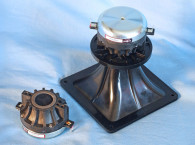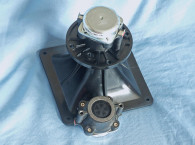
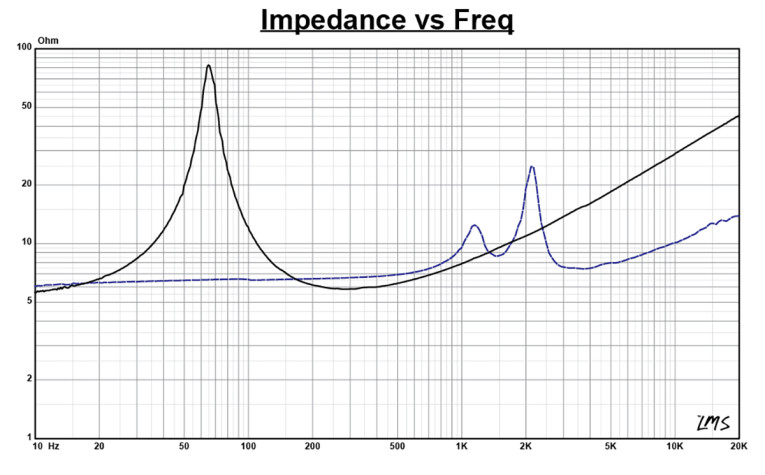

In terms of features, the 5CXN44 woofer is built on an eight-spoke (four twin spokes) cast-aluminum frame that is thin enough to minimize any early reflections back into the rear of the cone. Cooling for this driver is exclusively provided by the motor mass, which is substantial given the large 84mm diameter (6mm thick) neodymium ring magnet that powers both high-frequency and low-frequency units, and the 12mm thick milled front plate and 15mm thick milled back plate. There is also an aluminum shorting ring (Faraday Shield) that contributes to the motor mass, but no other vents are required for the 300W power handling rating given by B&C Speakers to the 5.25” woofer section of the 5CXN44, which is impressive.
Diaphragm materials for the 5CXN44 include a curvilinear paper cone with a front-side waterproof coating for the woofer, and a high temperature (HT) polymer for the compression driver diaphragm. The woofer is suspended by an NBR surround with a nice shallow profile at the cone attachment, and a 3.25” diameter elevated cloth spider. Driving the cone assembly is a 44mm (1.7”) diameter voice coil with a Kapton former wound with round copper wire.
The compression driver has a 36mm (1.4”) diameter voice coil also with a Kapton former, but wound with aluminum wire. This HT polymer diaphragm fires into a short aluminum conical-shaped horn, which brings the sensitivity to 101dB, with a recommended crossover frequency of 2kHz. Terminals for the compression driver are located on the injection-molded diaphragm cover on the back of the motor structure and on the frame for the woofer. Applications for the 5CXN44 are primarily as a PA fill driver for small or separated spaces (e.g., under balconies).
Testing began with the woofer half of this coax driver using the LinearX LMS and Physical Box IMP Box (the same type of fixture as a LinearX VIBox) to create both voltage and admittance (current) curves with the driver clamped to a rigid test fixture in free-air at 0.3V, 1V, 3V, 6V, 10V, and 15V with the oscillator on time between sweeps to simulate the actual thermal process over time. The 15V curves were too nonlinear to get a sufficient curve fit and were discarded.
Following my established protocol for Test Bench testing, I no longer use a single added mass measurement and instead use the company-supplied Mmd data (14.5 grams for the 5CXN44). The collected data, in this case the 10 550-point (0.3V to 10V) sine wave sweeps for each B&C Speakers sample, were post-processed and the voltage curves divided by the current curves to generate impedance curves, with the phase derived using the LinearX phase calculation method.
I imported the data, along with the accompanying voltage curves, to the LEAP 5 Enclosure Shop software. Figure 1 shows the woofer’s 1V free-air impedance curve, along with the compression driver impedance curve). Table 1 compares the LEAP 5 LTD/TSL Thiele-Small pareameter data and factory parameters for both of the B&C Speakers 5CXN44 samples.

Parameter measurement results for the 5CXN44 were reasonably close to the B&C Speakers’ factory data, except for the Xmax numbers, but only because B&C Speakers, like several other manufacturers, includes fringe-field compensation in their Xmax numbers. Since everything looked good, I proceeded to set up two computer enclosure simulations using the LEAP LTD parameters for Sample 1. This produced a sealed Butterworth Qtc=0.7 alignment box with a 295 in3 volume and 50% fiberglass fill material, and a vented Chebychev/Butterworth alignment with a 300 in3 box volume tuned to 50Hz, and with 15% fiberglass fill material.
Figure 2 displays the results for the 5CXN44 woofer in the sealed and vented enclosures at 2.83V and at a voltage level sufficiently high enough to increase cone excursion to Xmax + 15% (4.6mm for the 5CXN44). This produced a F3 frequency of 88Hz (-6dB = 69.5Hz) for the 295 in3 box with a Qtc=0.7, and a –3dB = 73Hz (-6dB = 55Hz) for the 300 in3 vented box. Maximum linear excursion (Xmax + 15%) resulted in 103dB at 17V for the sealed box simulation and 106.5B at a 22V input for the vented enclosure. Figure 3 shows the 2.83V group delay curves. Figure 4 shows the 17V/22V excursion curves.

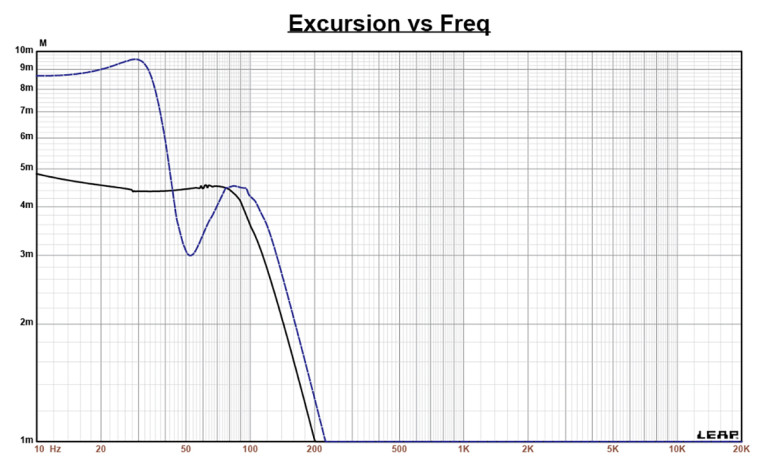
Klippel analysis for the B&C Speakers woofer half of the 5CXN44 was performed for this article by Redrock Acoustics (Patrick Turnmire) with the Klippel DA2 distortion analyzer (as mentioned previously, I will be splitting the Klippel analysis between Redrock Acoustics and Warkwyn). The Bl(X) curve for 5CXN44 shown in Figure 5 is symmetrical and moderately broad, especially for a 5.25” driver, but with a total lack of “tilt” and nearly zero offset. The Bl symmetry curve shown in Figure 6 displays zero offset once the graph reached a place of certainty from about 2mm to beyond Xmax.
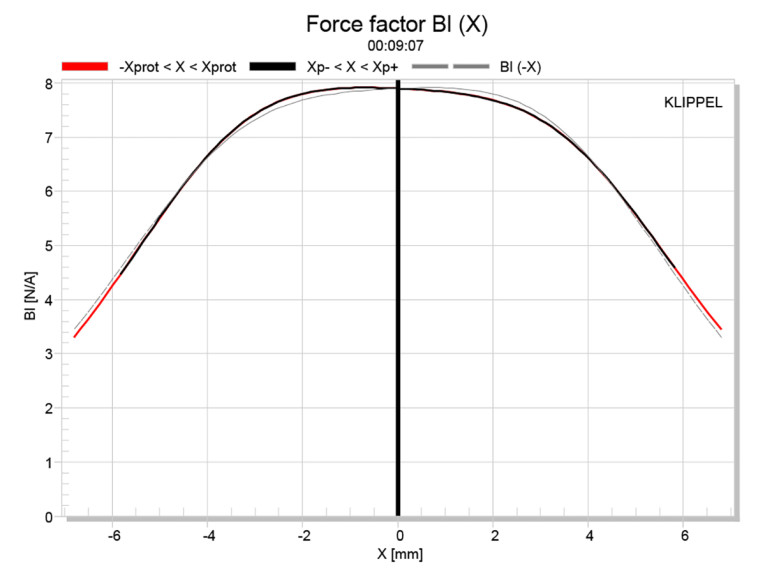

Figure 7 and Figure 8 and show the Kms(X) and Kms symmetry curves for the 5CXN44 coax. The Kms stiffness of compliance curve shown in Figure 7 is also broad and symmetrical and with virtually no offset. The Kms symmetry range curve shown in Figure 8 also indicates no offset at all for the entire range of this transducer.


Displacement limiting numbers calculated by the Klippel analyzer using the full-range woofer criteria for Bl was XBl @ 82% (Bl dropping to 82% of its maximum value) was 4.2mm (slightly greater than the Xmax for the 5CXN44) for the prescribed 10% distortion level. For the compliance, XC @ 75% Cms minimum was only 3.5mm, which means that for the B&C Speakers woofer section of this coax driver, the compliance is the more limiting factor for getting to the 10% distortion level. However, if we use the less conservative 20% distortion criteria, XBl @ 70%=5.0mm and XC @ 50%=4.7mm, showing both numbers exceeding the 4mm physical Xmax of this driver.
Figure 9 gives the inductance curves Le(X) for the 5CXN44. Inductance will typically increase in the rear direction from the zero rest position as the voice coil covers more pole area, which is what is happening here, typical of this type of neo motor that incorporates an aluminum demodulation (shorting) ring. The maximum inductance swing for this driver from Xmax in to Xmax out is a moderately low 0.39mH maximum, which is good performance for this dual driver (woofer and compression driver) neodymium motor.

With the Klippel analysis completed, I proceeded to mount the 5CXN44 in an enclosure, which had a 12” × 7” baffle, filled with foam damping material. Then I measured both the midrange and the compression driver both on- and off-axis from 200Hz to 40kHz at 2V/0.5m, normalized to 2.83V/1m using the LoudSoft FINE R+D analyzer and the GRAS 46BE microphone (courtesy of LoudSoft and GRAS Sound & Vibration).
Figure 10 gives the 5CXN44 woofer’s on-axis response along with the compression driver’s on-axis response. The woofer has a smooth rising response out to 1.8kHz where it begins typical second-order low-pass roll-off beginning with no serious anomalies. For the compression driver, the response low-pass roll-off begins at 2kHz, followed by a break-up mode centered on 1.7kHz.

Figure 11 depicts the woofer’s on- and off-axis frequency response at 0°, 15°, 30°, and 45°. A -3dB at 30° with respect to the on-axis curve occurs at 1.8kHz, making 1.5kHz to 2kHz a reasonable crossover range. Figure 12 gives the normalized version of Figure 11, and Figure 13 depicts the CLIO 180° polar pot (in 10° increments). And last, Figure 14 gives the two-sample SPL comparisons for the 5CXN44 samples, both samples obviously closely matched within 0.5dB to 1dB within the woofers operating range.
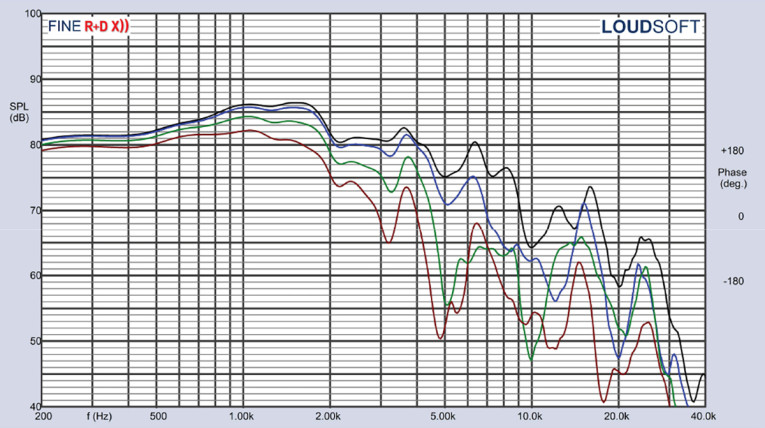
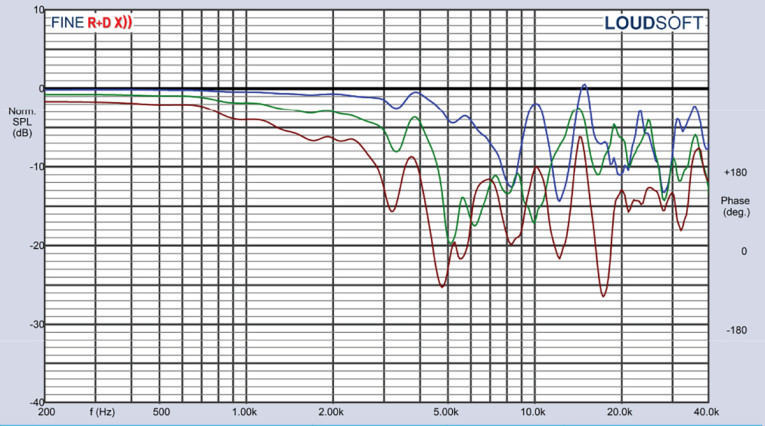
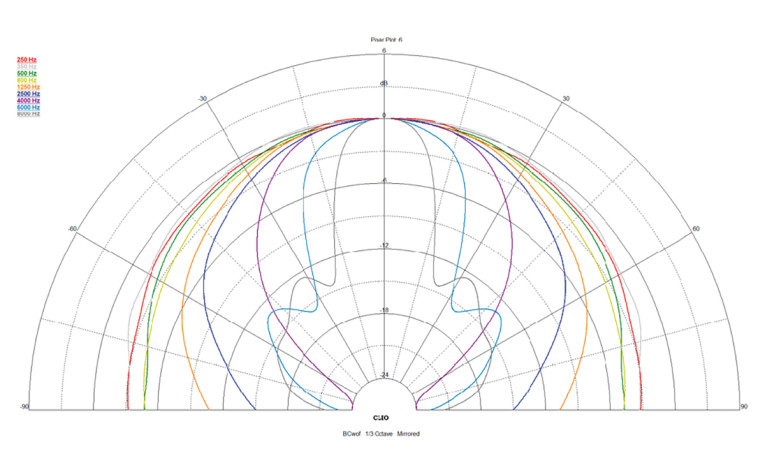

For the compression driver, Figure 15 shows the on- and off-axis horizontal frequency response out to 45°, with the normalized version shown in Figure 16, and the CLIO 180° polar plot (processed in 10° increments) shown in Figure 17. Figure 18 depicts the two-sample SPL comparison for the compression driver half of the 5CXN44 coax, which is within 1dB above 2kHz.
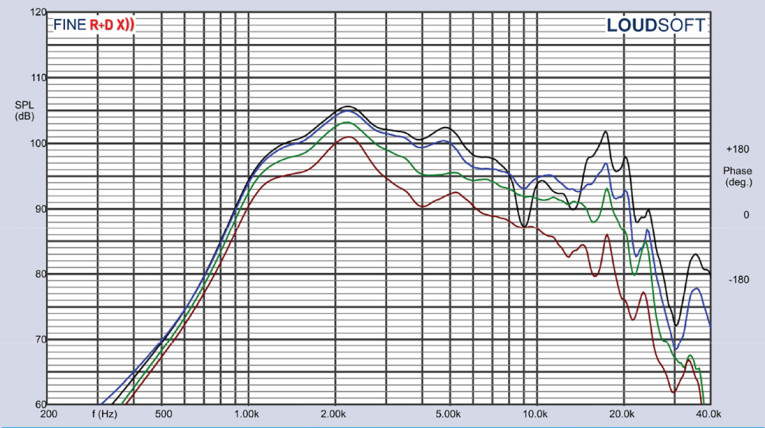
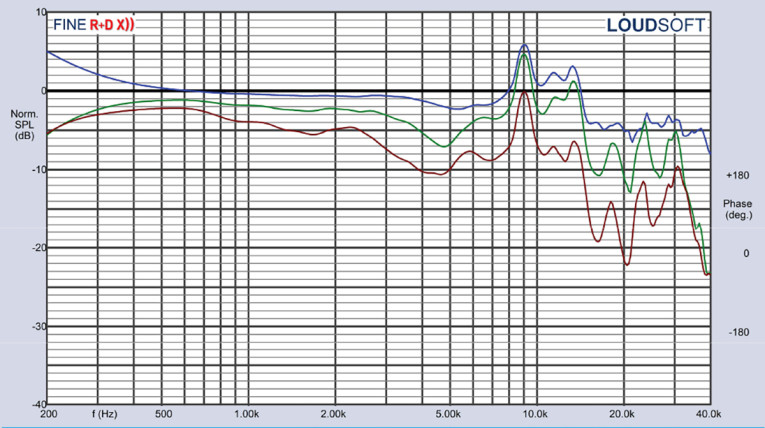
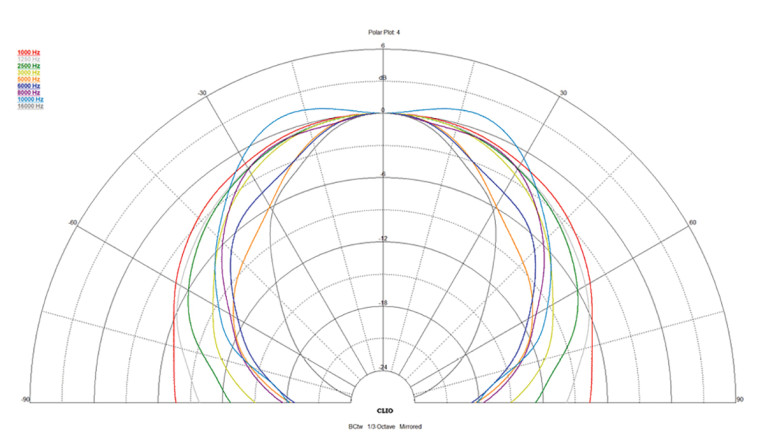
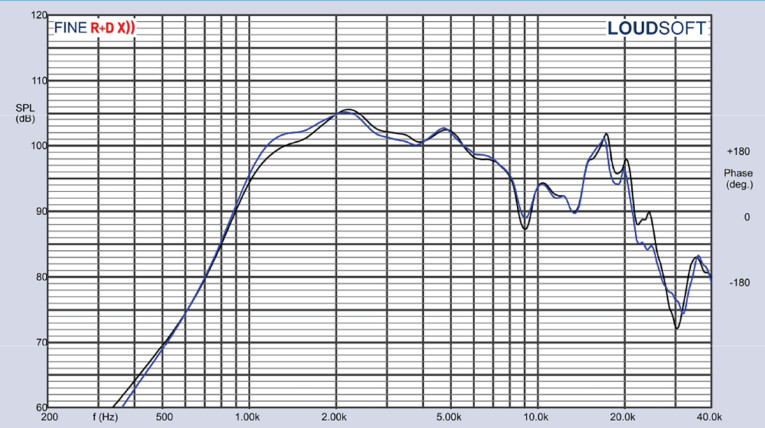
The final group of tests was performed using the Listen, Inc. AmpConnect analyzer and SC-1 microphone (courtesy of Listen, Inc.) along with the SoundCheck software to measure distortion and generate time-frequency plots. Setting up for the distortion measurement consisted of mounting the driver rigidly in free-air, and determining the voltage level needed to raise the SPL to 94dB at 1m, using a pink noise stimulus. Then, I measured the distortion with the Listen microphone placed 10cm from the midrange dust cap and tweeter dome. Figure 19 shows the distortion curves this produced for the midrange (11.4V). Figure 20 shows the distortion curves for the tweeter dome (1.17V).
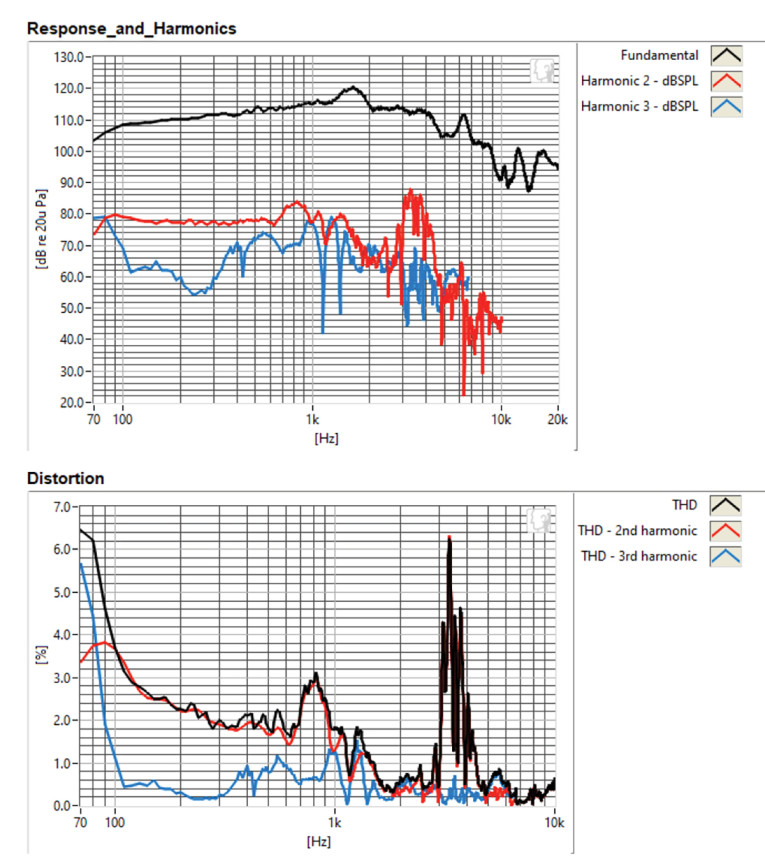

With the distortion test completed, I set up SoundCheck to produce a 2.83V/1m impulse response for both the woofer and the compression driver and imported the data into Listen’s SoundMap Time/Frequency software. Figure 21 shows the resulting cumulative spectral decay (CSD) waterfall plot for the 5CXN44 woofer. Figure 22 shows the CSD waterfall plot for the compression driver. For the final SoundMap graphic output, Figure 23 gives the woofer’s Wigner-Ville logarithmic surface map (chosen for its better low-frequency performance). Figure 24 displays compression driver’s Short Time Fourier Transform (STFT) plot.
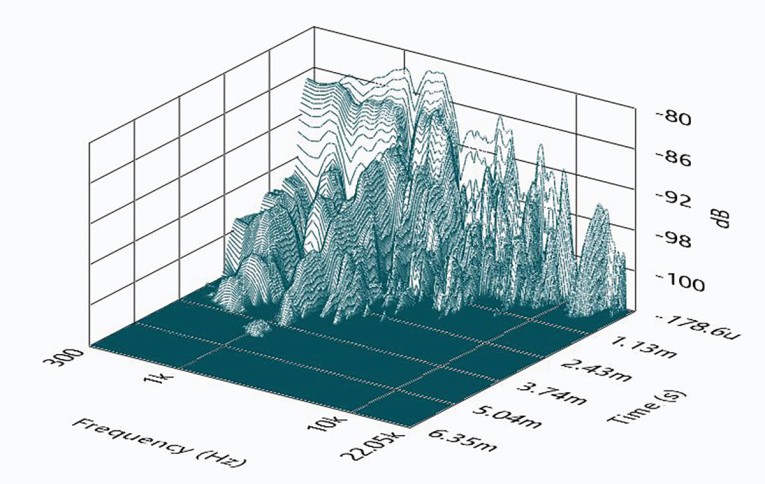

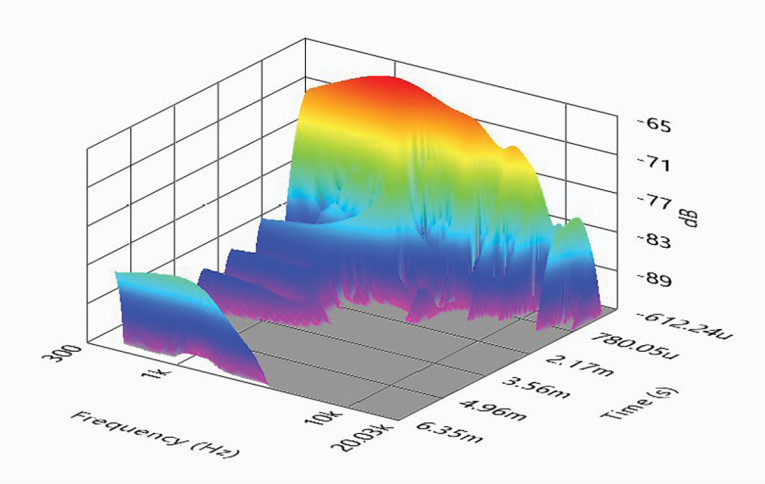
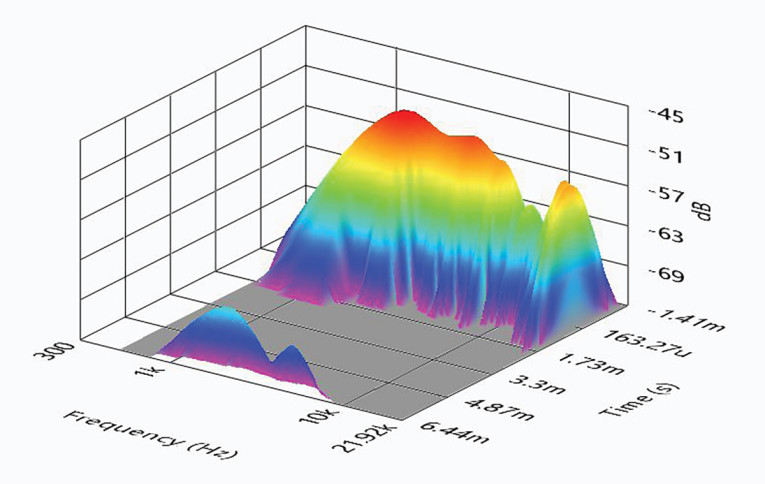
As one of the premier pro sound OEMs, B&C Speakers’ products are consistently well engineered with good performance characteristics, and certainly the 5CXN44 is great example of the company’s craft. For more information, visit www.bcspeakers.com. VC
This article was originally published in Voice Coil, August 2021.





